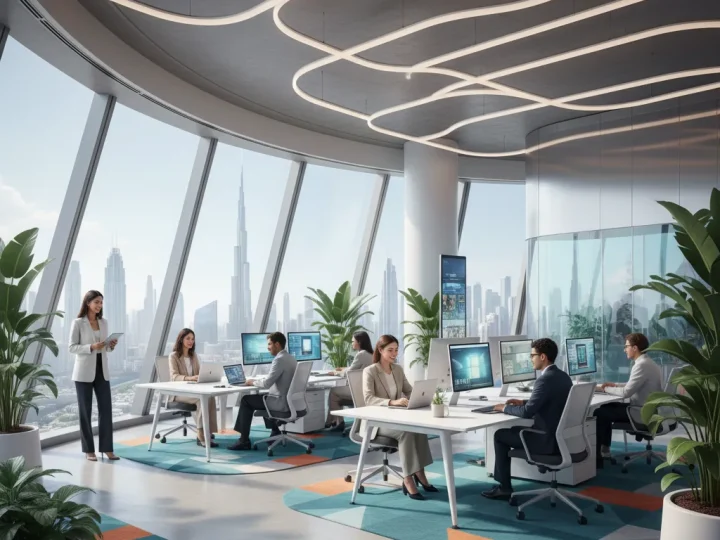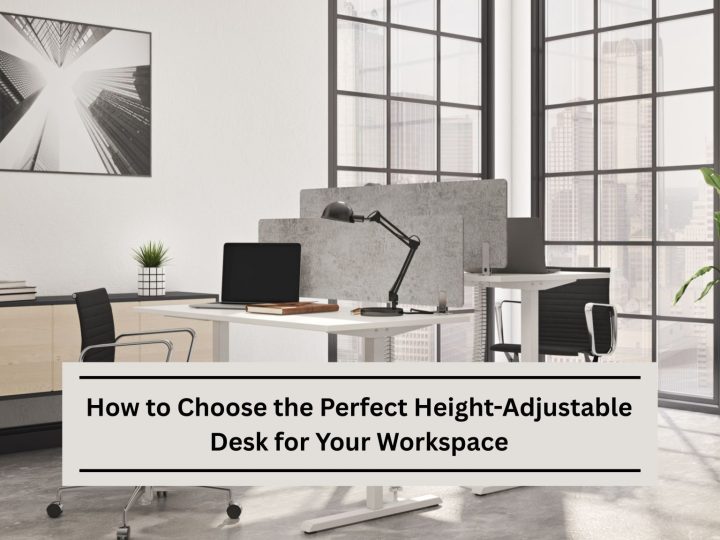

Office chairs are often overlooked, yet they play a pivotal role in enhancing workplace comfort and productivity. Studies reveal that nearly 40 percent of workers suffer from back pain, a common consequence of sitting in poorly designed chairs. But here’s the surprising twist: investing in the right office chair can transform your work experience entirely. Rather than merely a supportive seat, the right chair can boost your efficiency and protect your health, making it one of the most crucial decisions in your workspace.
Table of Contents
- Understanding Office Chair Designs
- Functional Differences In Office Chairs
- Ergonomic Benefits Of Various Chairs
- Choosing The Right Office Chair Type
Quick Summary
| Takeaway | Explanation |
|---|---|
| Ergonomic Chair Design is Essential for Health | Office chairs with comprehensive ergonomic features can significantly reduce musculoskeletal disorders and discomfort, enhancing workplace health and productivity. |
| Task Chairs Optimize Focused Work | Task chairs are specifically engineered for productivity, featuring customizable adjustments that cater to individual ergonomic needs, thus minimizing strain during extensive periods of sitting. |
| Hybrid Chairs Support Diverse Work Activities | Modern hybrid work chairs provide adaptable support for various modes of work, integrating advanced features like posture monitoring and temperature regulation to enhance user comfort and productivity. |
| Selecting the Right Chair is Personalized | Choosing an office chair should be tailored to individual needs, considering factors like work duration, primary activities, and physical characteristics to ensure optimal physical alignment and comfort. |
| Specialized Chairs Address Unique Requirements | Different professional environments necessitate specific chair designs, such as mobility for creative professionals and long-duration comfort for administrative roles, highlighting the importance of targeted ergonomic solutions. |
Understanding Office Chair Designs
Office chair designs have evolved dramatically, transforming from simple sitting solutions to sophisticated ergonomic systems that prioritize worker health, productivity, and comfort. Modern chair designs reflect a complex intersection of biomechanical engineering, materials science, and workplace ergonomics.
The Anatomy of Professional Chair Designs
At the core of contemporary office chair design are multiple critical components that determine overall functionality and user experience. These include the base, seat mechanism, backrest, armrests, and adjustment systems. Each element plays a strategic role in providing support and adaptability. Research from Ergonomics Journal indicates that chairs with comprehensive adjustment mechanisms can reduce workplace musculoskeletal disorders by up to 35%.
Modern office chairs typically feature sophisticated mechanisms like:
- Lumbar Support: Contoured designs that maintain natural spine curvature
- Height Adjustment: Pneumatic systems allowing precise vertical positioning
- Tilt Mechanisms: Enabling dynamic sitting and weight distribution
Emerging Design Philosophies in Office Seating
Contemporary office chair designs are increasingly driven by the concept of intelligent customization. According to innovative research, emerging design philosophies focus on creating chairs that can rapidly adapt to individual user requirements. This means chairs are no longer one-size-fits-all but instead represent personalized ergonomic solutions.
The hybrid work environment has particularly influenced chair design. Sihoo Office Trends Report highlights that modern chairs must now support multiple work modes—from concentrated individual tasks to collaborative video conferences and relaxation periods.
Materials and Technological Integration
Breathable mesh materials have revolutionized office chair construction, offering enhanced ventilation and lightweight support. Advanced chairs now incorporate high-performance textiles that regulate temperature, manage moisture, and provide targeted compression. Some cutting-edge designs even integrate sensors to monitor posture and provide real-time ergonomic feedback.
The differences in office chair types are no longer just about aesthetic variations but represent sophisticated solutions addressing complex workplace ergonomic challenges. From executive leather models to minimalist mesh designs, each chair type embodies a unique approach to supporting human physiology and work performance.
Understanding these nuanced differences in office chair types requires appreciating the intricate balance between form, function, and human-centered design principles. As workplace environments continue to evolve, so too will the sophisticated science of office chair engineering.
Functional Differences in Office Chairs
Office chairs are not merely furniture pieces but complex ergonomic tools designed to support diverse workplace activities and individual physiological needs. The functional differences between chair types can significantly impact worker comfort, productivity, and long-term health.
Task Chair Configurations: Precision Engineering for Productivity
Task chairs represent the pinnacle of functional design, engineered specifically for focused work environments. Ergonomic Research Institute indicates these chairs prioritize adjustability and support, featuring mechanisms that enable precise customization. Unlike generic seating options, task chairs offer nuanced adaptations such as:
- Dynamic Lumbar Support: Allows vertical and depth adjustments to match individual spine curvatures
- Synchronized Tilt Mechanisms: Enables proportional movement between seat and backrest
- 360-Degree Swivel Base: Facilitates seamless movement without compromising stability
According to CNET’s Office Furniture Analysis, task chairs differentiate themselves by providing targeted ergonomic solutions that minimize physical strain during extended work periods.
Executive and Specialty Chair Variations
Executive chairs diverge from task chairs by emphasizing aesthetic prestige alongside functional requirements. Workplace Design Journal notes these chairs typically feature premium materials like leather, broader dimensions, and more substantial padding. While less focused on micro-adjustments, executive chairs communicate professional status and provide comfort for leadership roles.
Specialty chairs further demonstrate the differences in office chair types by catering to specific workplace needs. Drafting chairs for architects, ergonomic chairs for developers, and healthcare-specific seating all represent unique functional adaptations designed for particular professional contexts.
Hybrid Work Chair Innovations
The evolving workplace landscape has sparked remarkable innovations in chair functionality. Sihoo Office Trends Report highlights emerging multi-use chair designs that support seamless transitions between focused work, collaborative sessions, and relaxation modes.
Modern hybrid work chairs integrate advanced features like:
- Adaptive recline mechanisms
- Temperature-regulating fabrics
- Posture-monitoring sensor technologies
These technological advancements represent a paradigm shift from traditional static seating toward dynamic, intelligent workplace solutions. By recognizing that different work activities demand unique ergonomic support, manufacturers are creating increasingly sophisticated chair designs.

The functional differences in office chair types reflect a deeper understanding of human physiology, workplace dynamics, and the critical relationship between physical comfort and professional performance. As work environments continue transforming, chair designs will undoubtedly evolve to meet emerging workplace challenges and individual user needs.

Ergonomic Benefits of Various Chairs
Ergonomic chairs transcend mere seating solutions, representing critical interventions in workplace health and productivity. The strategic design of different chair types offers targeted physiological support, directly impacting worker well-being and performance.
Spine and Posture Protection Mechanisms
Consensus Research Platform reveals that ergonomic chairs, when combined with proper ergonomic training, significantly reduce musculoskeletal risks and minimize discomfort symptoms throughout the workday. Specialized chair designs offer nuanced support strategies:
- Lumbar Support: Maintains natural spine curvature
- Adjustable Height Mechanisms: Align body to optimal working positions
- Dynamic Tilt Features: Distribute body weight evenly
Professional research indicates that proper chair ergonomics can reduce lower back strain by up to 40%, preventing long-term physical complications associated with prolonged sitting.
Performance and Productivity Correlations
Global Workplace Comfort Studies demonstrate a direct correlation between ergonomic chair design and workplace productivity. Chairs that provide comprehensive support enable workers to maintain focus, reduce fatigue, and sustain higher energy levels throughout complex work tasks.
Understanding the differences in office chair types becomes crucial when recognizing how specific design elements contribute to enhanced workplace performance. Executive chairs might prioritize comfort for leadership roles, while task chairs focus on supporting intense, concentrated work environments.
Adaptive Ergonomic Technologies
Welax Chair Ergonomic Research highlights emerging chair technologies that go beyond traditional support mechanisms. Modern ergonomic chairs now incorporate advanced features like:
- Pressure-sensing materials
- Real-time posture monitoring systems
- Adaptive support technologies that automatically adjust to user movements
These innovations represent a sophisticated approach to workplace seating, transforming chairs from passive furniture into active health and performance management tools. By recognizing individual physiological needs, manufacturers are creating increasingly personalized ergonomic solutions.
The evolution of ergonomic chair design reflects a profound understanding that human comfort directly influences professional effectiveness. As workplace dynamics continue transforming, ergonomic chair technologies will undoubtedly become more intelligent, responsive, and tailored to individual user requirements.
Choosing the Right Office Chair Type
Selecting the appropriate office chair is a critical decision that extends far beyond aesthetic preferences. The right chair can significantly impact workplace productivity, physical health, and overall professional performance. Understanding the nuanced differences in office chair types requires a strategic approach to matching chair characteristics with individual work requirements.
Assessing Individual Work Environment Needs
Ergonomic Workplace Research Institute emphasizes that chair selection should be a personalized process considering multiple factors. Key considerations include:
- Work Duration: Number of hours spent seated daily
- Primary Work Activities: Typing, meetings, creative work
- Physical Characteristics: Body height, weight, and unique ergonomic requirements
Furniture Design Journal suggests that different professional roles demand specific chair configurations. Task chairs suit dynamic work environments, while executive chairs provide enhanced comfort for leadership positions requiring extended seated periods.
Critical Ergonomic Selection Criteria
Beyond basic functionality, advanced chair selection involves evaluating comprehensive ergonomic features. Critical elements include:
- Adjustable lumbar support
- Seat depth and width compatibility
- Customizable Height Mechanisms: Ensuring proper alignment with workstations
- Weight distribution capabilities
Professional ergonomists recommend chairs that allow multiple adjustment points, enabling users to create personalized sitting configurations that support natural body mechanics. The goal is minimizing physical strain while maximizing comfort and productivity.
Specialized Chair Recommendations by Professional Context
Different professional environments require targeted seating solutions. For instance:
- Creative Professionals: Chairs with increased mobility and flexible positioning
- Technology Workers: Chairs with enhanced lower back support and cooling mechanisms
- Administrative Roles: Chairs prioritizing long-duration comfort and subtle movement support
The differences in office chair types become most apparent when examining how specialized designs address unique workplace challenges. A software developer’s requirements dramatically differ from those of a graphic designer or executive manager.
Ultimately, choosing the right office chair represents an investment in personal health and professional performance. By carefully evaluating individual needs, workplace dynamics, and ergonomic features, professionals can select chairs that not only support their physical well-being but also enhance overall work effectiveness.
Remember that no single chair represents a universal solution. The most effective approach involves testing multiple options, understanding personal ergonomic requirements, and prioritizing long-term physical comfort alongside immediate functional needs.
Frequently Asked Questions
What are the main types of office chairs?
There are several main types of office chairs, including task chairs, executive chairs, specialty chairs, and hybrid work chairs. Each type is designed for specific use cases and offers different ergonomic features suited to various work environments.
How do ergonomic chairs benefit health?
Ergonomic chairs are designed to support the natural curvature of the spine and promote proper posture, which can reduce the risk of musculoskeletal disorders and discomfort during long periods of sitting. They typically include features like adjustable lumbar support and seat height.
What should I look for when choosing an office chair?
When choosing an office chair, consider factors such as adjustability (height, lumbar support, etc.), the duration of usage, your primary work activities, and your individual physical characteristics. Prioritizing ergonomic features will help ensure comfort and productivity.
Can hybrid office chairs accommodate different work styles?
Yes, hybrid office chairs are designed to support various work activities, providing flexibility for tasks ranging from concentrated individual work to collaborative meetings. They often include features like posture monitoring and temperature regulation to enhance comfort.
Transform Your Workspace with the Perfect Office Chair
Are you one of the 40 percent of workers suffering from back pain due to poorly designed office chairs? The article highlights how selecting the right office chair can elevate productivity and protect your health, yet many still overlook this crucial investment. From task chairs engineered for short bursts of intense focus to executive chairs that exude professionalism, identifying your specific needs is the first step toward a pain-free work experience.

At SAGTCO, we understand that each professional environment is unique. That’s why we offer an extensive catalog of modern and customizable office solutions tailored to enhance both aesthetics and functionality. Our expert consultation services can guide you towards the ideal chair suited to your work style and individual ergonomic requirements. Don’t let discomfort stand in the way of your productivity—visit SAGTCO.com today to explore our diverse chair options and take the first step towards a healthier workspace!




